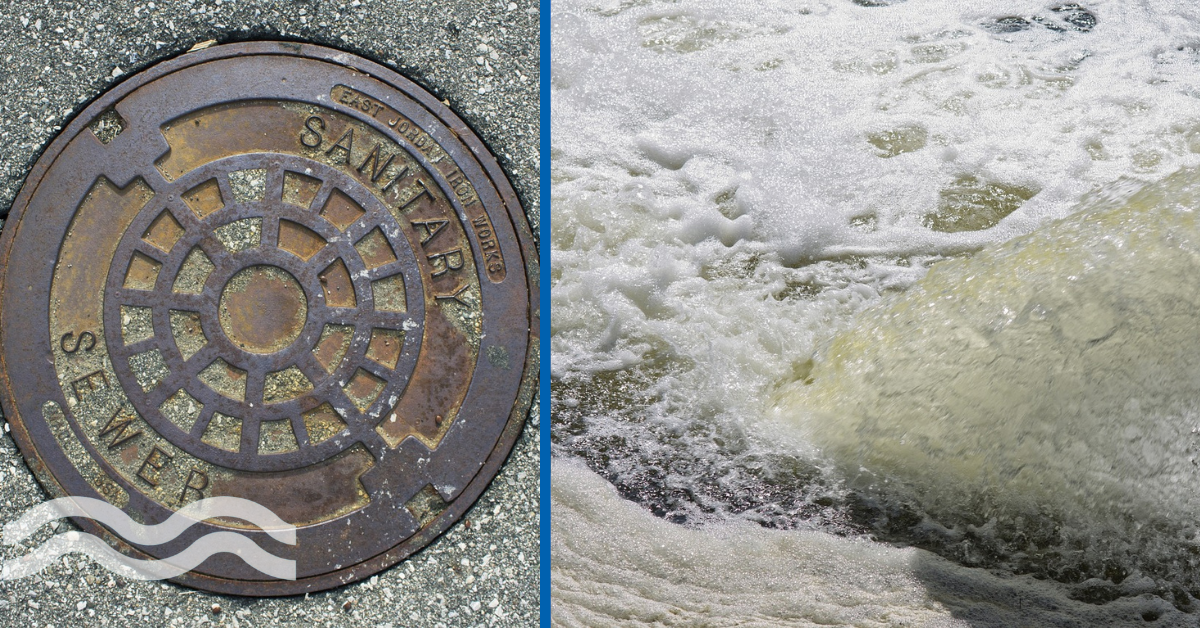
In a bid to revolutionise home heating and reduce environmental impact, water companies are turning to an unconventional source – sewage. Sewage heat recovery (SHR) is gaining momentum as a reliable and renewable energy solution. We delve into the innovative world of SHR and understand why water companies are investing in this forward-thinking approach.
Sewage water, often dismissed as waste, boasts a hidden asset – a constant and stable temperature. This inherent quality makes it an ideal, yet largely untapped, source of renewable heat.
The key steps in SHR involve heat exchangers, electrical heat pumps and a distribution system. The process begins at a sewage treatment plant where wastewater from various sources undergoes treatment.
Heat exchangers are employed to transfer thermal energy from the sewage water to a separate fluid, such as water or refrigerant. This transfer occurs without direct contact between the sewage water and the secondary fluid, ensuring hygienic and efficient heat extraction.
Once the thermal energy is extracted from the sewage water, it typically needs to be further elevated to reach temperatures suitable for residential heating. Electrical heat pumps play a crucial role in this stage. They receive the moderately heated fluid from the heat exchangers and use electricity to further boost its temperature. Recovered heat is at a level that can effectively warm homes during colder periods.
The now-elevated and heated fluid needs a system for efficient distribution to homes or buildings. A distribution system, often a network of pipes, is employed to transport the heated fluid from the sewage heat recovery facility to residential areas. This infrastructure ensures that the warmth derived from sewage is effectively delivered to end-users.
One of the key advantages of sewage heat recovery is the relatively stable temperature of sewage water throughout the year. Unlike external weather conditions, sewage water maintains a consistent temperature, providing a reliable and steady source of heat.
By harnessing the thermal energy from sewage, the process reduces the reliance on traditional heating methods powered by fossil fuels. This contributes to a reduction in the overall carbon footprint associated with residential heating, aligning with sustainable and eco-friendly energy practices.
Vancouver, Canada, has emerged as a trailblazer in sustainable energy practices by tapping into the potential of SHR. Approximately 6,210 apartments in False Creek, an area of the city, are now warmed by the innovative use of heat from wastewater, making sewage heat the primary contributor to renewable energy sources for heating.
The Seven35 Condo residential estate in the city also successfully reduced its greenhouse gas (GHG) emissions by an impressive 150 tonnes using SHR. A SHARC wastewater heat recovery system was used, which now recovers 80 per cent of wasted energy.
In an article on the project from the BBC, Derek Pope, the manager of Neighbourhood Energy for the city of Vancouver, emphasizes the transformative impact of SHR. Underneath the city's streets, a network of sewage systems exudes heat. The process involves strategically placed energy centres, equipped with heat pumps that cool down warm sewage before it reaches treatment plants.
By concentrating and elevating the temperature of the extracted heat, scalding hot water is produced, reaching up to 80°C. Pope says the system operates with remarkable efficiency, achieving over 300 per cent efficiency in converting electricity into thermal energy.

This forward-thinking initiative not only demonstrates the viability of sewage heat as a renewable energy source but also aligns with Vancouver's commitment to combat climate change. Buildings in the city contribute over 50 per cent of greenhouse gas emissions, primarily due to the use of natural gas for heating. Using waste heat from sewage offers a powerful tool for reducing emissions at the neighbourhood scale, especially in densely populated areas.
As part of Vancouver's climate emergency action plan, the False Creek Neighbourhood Energy Utility, owned and operated by the city, aims to achieve fully renewable heat sources by 2030. The success in False Creek has spurred an expansion of district energy systems across Greater Vancouver, with many adopting or planning to adopt sewage heat as a primary energy source, marking a significant shift away from traditional fossil fuels.
While challenges remain, including upfront capital costs and the need for integrated urban planning, Vancouver's SHR initiatives serve as a compelling model for municipalities worldwide aiming to embrace sustainable heating solutions.
Amsterdam is also set to utilise SHR. Dutch housing association Lieven de Key plans to tap into a primary district sewage pipe to provide warmth for 1,600 existing social and student homes.
‘Riothermie’, named after the Dutch words for sewer (riöol) and warmth, is a 24/7, year-round heat source that marks a significant leap towards greener and more efficient urban heating in the city.
Amid initial skepticism, Lieven de Key engaged in discussions with Liander, a company specialising in underground connections and collaborated with the water board to bring the idea to life. The concept involves utilizing water-fueled heat pumps in buildings to capture heat from the collective sewer, a constant and warm flow generated by showers, toilets, and various household appliances. The captured heat is then transported to homes through insulated pipes, undergoing a process where a heat exchanger raises its temperature to a medium level of 60-70°C.

Project leader Jeroen Rademaker said in an article in the Guardian: “We have a photo of the street covered with snow, and the manhole covers all without snow. Even when there’s snow in the winter, the sewer is warm. Warm sewage water flows 24 hours a day and we should capture it. This can happen wherever there is a big sewage pipe.”
This visionary project aligns with Amsterdam's broader climate emergency action plan, aiming for fully renewable heat sources by 2030.
Meanwhile, in Raalte, The Netherlands, the Waterboard Groot Salland has created a sustainable swimming pool by heating water with treated wastewater, employing four 59 kW heat pumps. This initiative has led to a reduction of 137 tonnes of CO2 emissions per year, a 33 per cent decrease in gas usage and annual savings of €25,000 on gas expenses.
Meanwhile, Switzerland continues to demonstrate the effectiveness of wastewater heat recovery with the Seeblick multi family residence in Uster. This project, comprising 52 flats across three buildings, avoided the use of 157 tonnes of oil and 172,000 Nm³ of gas by utilising heat from wastewater for both space and water heating. As a result, emissions were significantly reduced to a range of 340 to 412 tonnes of CO2 annually.
The trend extends to Norway, where half of the energy used in Sandvika, Oslo, is supplied by a wastewater treatment plant utilizing four heat pumps. This innovation reduces CO2 emissions by an impressive 6000 tons per annum.
In the UK, there is a growing interest in wastewater heat recovery, particularly after the success of a small pilot project at Borders College in Galashiels, Scotland. This venture, a collaboration between Scottish Water Horizons and SHARC Energy Systems, commenced operations in December 2015.
With two 400kW heat pumps producing 1.9 GWh annually, the system meets around 95 per cent of the college's heat demand with no adverse effects on the local sewer network. The project results in an annual carbon saving of 170 tonnes of CO2 and substantial monetary savings, amounting to around £10,000 annually when compared to conventional gas boiler heating.
While SHR presents numerous benefits, water utilities must grapple with certain drawbacks. A primary concern is the substantial infrastructure costs associated with implementing these systems, posing a significant hurdle to widespread adoption. Retrofitting existing buildings and sewage systems demands a considerable upfront investment, potentially limiting the feasibility of SHR on a large scale.
Sewage systems, prone to wear and tear, introduce maintenance challenges as solids and debris in wastewater may impact the efficiency of heat exchangers and pumps. Regular maintenance becomes imperative to ensure the longevity and optimal performance of the system.
Public resistance, stemming from perceived hygiene concerns, presents another challenge. Overcoming the "yuck" factor and fostering public acceptance stands as a potential obstacle in the broad implementation of SHR.
While sewage water generally maintains a stable temperature, variations can occur due to seasonal changes and fluctuations in water usage patterns, especially in extremely cold climates, affecting system efficiency.
Adhering to regulatory standards is crucial to ensuring that recovered heat doesn't compromise the wastewater treatment process. Changes in sewage water temperature could potentially impact the efficiency of biological treatment in wastewater treatment plants.
The feasibility of sewage heat recovery hinges on the availability of a suitable and sizeable sewage system. In areas with smaller or less developed sewage networks, implementing SHR may prove impractical.
Introducing electrical heat pumps in the process adds an element of energy consumption. Depending on the electricity source, environmental implications may arise, especially if derived from non-renewable sources.
Space constraints can be a challenge, particularly in densely populated urban areas, where finding suitable locations for heat recovery infrastructure might be challenging.
While recovered heat itself doesn't carry odors, concerns related to air quality near sewage treatment plants or heat recovery facilities may emerge. This was evident in Great Grimsby, in the UK over a space of many years at the Anglian Water managed, Pyewipe sewage treatment plant which received a number of complaints from residents and was debated in parliament. Proper design and operational practices are necessary to mitigate these concerns.
In regions where sewage water temperatures are relatively low, the heat output from sewage may not suffice to meet home heating demands, necessitating additional energy sources.
Despite these challenges, sewage heat recovery offers an innovative and sustainable heating solution. Addressing these drawbacks requires careful planning, technological advancements, and community engagement to maximise the benefits of sewage heat recovery systems.